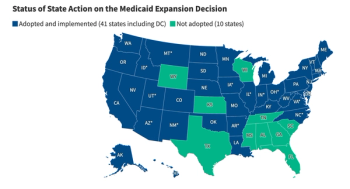
Study: Hospital-at-Home Program Benefits Severe COPD
Home non-invasive ventilation supports longer lives, fewer readmissions, and lower costs than other devices, based on findings of a KPMG study.
Chronic obstructive pulmonary disease (COPD) is the
Considering these devastating facts, if a safe, effective home-based treatment protocol existed that improved both COPD mortality rates and cost savings, one would assume it would be the treatment most widely adopted by physicians and paid for by insurers. A recent
KPMG compared outcomes of COPD patients with chronic respiratory failure (CRF). These clinical and cost outcomes were obtained from CMS data and consisted of patients prescribed either home bilevel positive airway pressure (BPAP) or home non-invasive mechanical ventilation (NIV), or those who were prescribed no ventilation support device. The study showed a 42% reduction in relative mortality for patients treated by either NIV or BPAP. However, the patients prescribed BPAP or who were untreated both had much higher hospitalization rates and greater overall health costs than did the NIV patients.
In this era of value-based care, providers and managed care organizations need to be aware of the total cost of care. Care and services need to achieve the Institute for Healthcare Improvement’s (IHI’s) Triple Aim of improving the patient experience of care (including quality and satisfaction); improving the health of populations; and reducing the per capita cost of healthcare. NIV therapy in conjunction with “high-touch” home care by a certified respiratory therapist meets these criteria and should be embraced across the industry as the standard of care for home treatment of COPD patients with CRF.
Existing protocols less effective
BPAP has been used to treat sleep apnea for years, and many physicians prescribe BPAP devices for COPD with CRF due to its long-established history of home use and the physicians’ resulting familiarity with it. On the surface-not taking into consideration outcomes-related healthcare costs-this older technology cost less on the front end than NIV, but more on the back end when you figure in hospitalization costs.
The KPMG study found that while immediate equipment costs for NIV may be greater than BPAP, in the long-term NIV is less expensive. Since in-home NIV is a newer technology than BPAP, more published research using BPAP is available. However, this recent study data suggests that the use of NIV coupled with an on-call respiratory therapist is the new standard of care in treating chronic respiratory failure patients diagnosed with COPD.
Significant cost and quality-of-life improvements
VieMed, a leading service provider of home respiratory care, including NIV devices, commissioned the study by KPMG, which reviewed four years of CMS data from 2013 through 2016 with over 17,000 patients. Mortality, costs, and place of service data were analyzed.
The most important study finding was that the mortality rate among patients using NIV compared to untreated patients was significantly lower. After six months of treatment, only 22% of COPD patients with CRF prescribed NIV had died compared with 38% of patients who were not prescribed NIV (42% reduction in relative mortality). The study also showed an overall reduction in absolute mortality of 16%.
Perhaps not surprisingly, inpatient cost disparities were also substantial. When looking at total costs for patients that qualified for therapy, inclusive of six months prior to therapy initiation and the six months after therapy, a total savings average of $15,067 was achieved by all groups. One NIV supplier saved $25,278 per patient per year for CMS.
Hospitalization rates back up these findings. Patients prescribed a BPAP were hospitalized at a rate of approximately 26% after six months, compared to 24% of patients prescribed NIV. It should be noted that patients of one supplier were hospitalized at a rate of less than 20%, theoretically because their high-touch model also includes multiple home visits by a certified respiratory therapist to ensure the NIV is being used correctly and to its maximum potential. That supplier’s clients also recorded the lowest monthly and accumulated post-treatment costs of all populations.
The enhanced level of patient education and support provided by the respiratory therapists likely had a significant positive effect on patient outcomes, experience, and overall costs, but the service feature was not specifically analyzed in the study.
Shortsighted benefits vs. long-term positive outcomes
The KPMG study results clearly demonstrate that the prevailing medical protocol of prescribing BPAP for COPD with CRF is outdated and should be replaced with NIV as a standard of care and covered service. With NIV, patients are hospitalized less, have lower healthcare costs and live longer.
The study findings offer compelling evidence that NIV therapy, particularly in conjunction with high-touch home care and education by a certified respiratory technician, offers true value-based care that encompasses lower costs along with better outcomes, experience and quality of life.
Casey Hoyt is CEO of VieMed.
Newsletter
Get the latest industry news, event updates, and more from Managed healthcare Executive.





















































